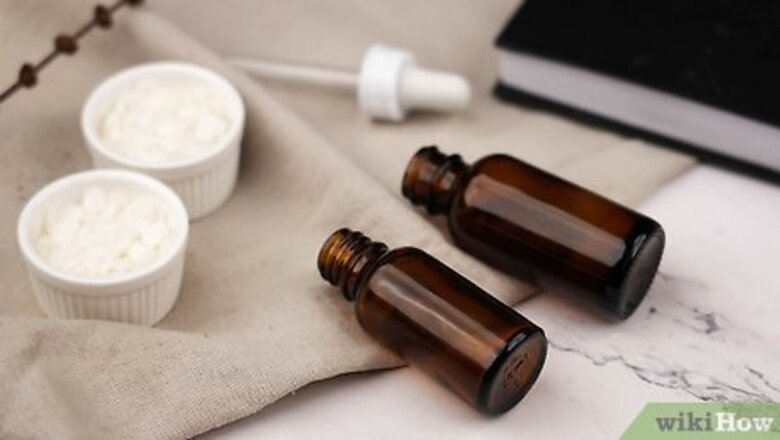
views
- Use a dark, amber bottle to keep your essential oil perfume as fragrant as possible.
- Add 15-20 drops of your base note (the scent that’ll last the longest). Then, add 10-15 drops of your middle note and 10 drops of your top note to finish your fragrance.
- Add 1 to 4 fl oz (2.0 to 8.0 US tbsp) of perfumer's alcohol or a carrier oil like jojoba to dilute the essential oils in your perfume.
Making Your Perfume
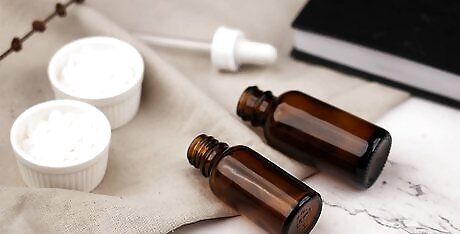
Use a dark-colored bottle to hold your perfume. Using a dark, amber-colored bottle is important because it helps preserve your fragrance by keeping the light out. Always shake your perfume before applying it so the scents mix within the bottle. When storing your bottle, keep it out of direct sunlight to ensure the oils stay fragrant. Try using an amber roller bottle for essential oils. These allow you to roll the perfume on your skin directly rather than spritzing it on.
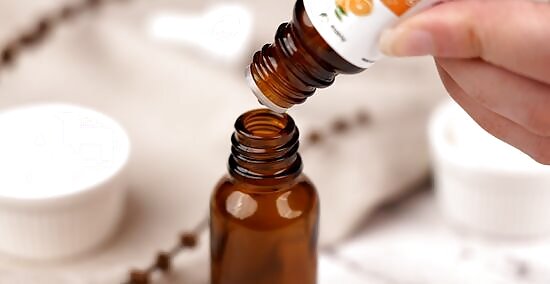
Add 15-20 drops of your base note. The first step to creating your fragrance is adding a base note or the scent that lasts the longest in your perfume. Base notes are often earthy scents that provide a lasting smell and can be 5 to 20 percent of your blend, but this varies. It's your personal preference, so experiment to see what scents you like. If you aren't sure where to start, follow this guideline: For a fresh and energizing perfume, add 17 drops of peppermint oil to your perfume bottle or roller bottle. For a floral and romantic blend, add 15 drops of ylang ylang oil. For a sensual and earthy fragrance, add 20 drops of vetiver oil.
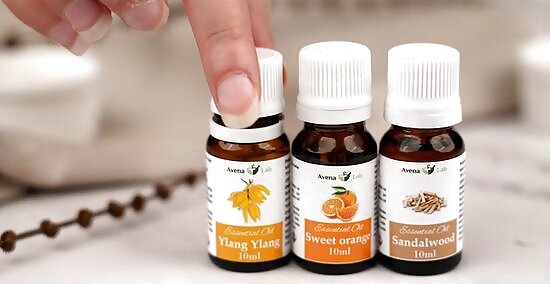
Mix in 10-15 drops of your middle note. The middle note is the heart of your fragrance, the smell that appears after your top note has dissipated. Some people choose to use a more floral scent for this note, but once again, it’s all about preference. Middle notes are usually the biggest portion of your blend (50 to 80 percent), but once again, this varies with experimentation. Here are some suggestions following the previous recipes: For a fresh and energizing perfume, add 10 drops of lime essential oil. For a romantic and floral blend, add 10 drops of orange essential oil. For a sensual, earthy fragrance, add 14 drops of ginger essential oil.
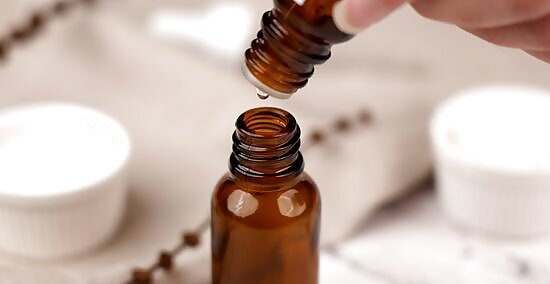
Add 10 drops of your top note. Finally, the last main addition to your perfume is the top note, or the scent you’ll notice first when applying your perfume. This note is often 5 to 20 percent of the blend, but you can add more or less if you choose. Some prefer fruity, minty, or refreshing scents for their top note. Try out different scents if you're unsure to see what you like the best, or follow these guidelines to finish the previous blends: For an energizing, fresh blend, add 10 drops of lavender oil. For a floral, romantic perfume, add 10 drops of rose essential oil. For an earthy, sensual fragrance, add 10 drops of cedarwood essential oil.
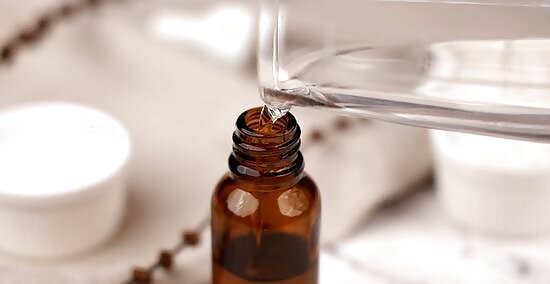
Add 1 to 4 fl oz (2.0 to 8.0 US tbsp) perfumer’s alcohol to dilute. Making an essential oil perfume with alcohol isn’t necessary, but the alcohol can help the fragrance last longer. Opt for a perfumer’s alcohol (which doesn’t have a scent) for the best results. If you’re using 60 or so drops of essential oils, use 3 to 4 fl oz (6.0 to 8.0 US tbsp) of alcohol. If you used 20 to 30 drops of essential oil, use 1 to 2 fl oz (2.0 to 4.0 US tbsp) of alcohol. Avoid using rubbing alcohol in your perfume, as the strong chemical odor can upset the balanced aroma of your perfume. For a more natural alternative, try a carrier oil like jojoba, sweet almond, or grapeseed. These oils have a minimal odor and work best in a roller ball bottle.

Shake your perfume, let it rest for a month, and then use it. After you’ve added all your ingredients to your fragrance, shake it up. This will allow the scents to fuse and mingle. Then, if you’re patient enough, let the perfume sit for about a month before using it. While you can use it beforehand, the scents will meld and become stronger the longer it rests. A perfume made out of essential oils may smell great right away, but over time, the scents could combine into something that doesn't smell too great. Allowing your perfume to sit will give you a better idea of what your combined scents will smell like for the majority of the perfume's life. Keep your perfume in a cool, dry place for the best results. Apply the perfume to your pulse points, such as your wrists, inner arms, the backs of your ears, and your sternum.
Essential Oil Perfume Recipes

Sassy Blend 4 drops grapefruit 14 drops geranium 6 drops ginger 2 fl oz (4.0 US tbsp) of carrier oil or perfumer’s alcohol
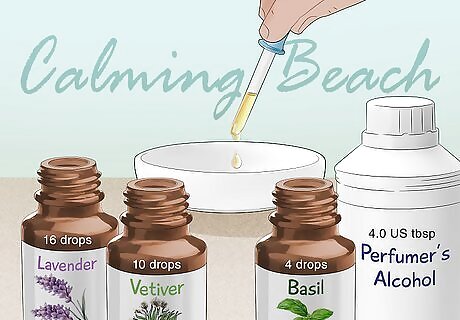
Calming Beach Blend 16 drops lavender 10 drops vetiver 4 drops basil 2 fl oz (4.0 US tbsp) of carrier oil or perfumer’s alcohol
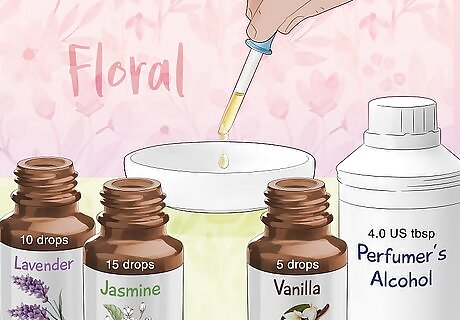
Floral Blend 10 drops lavender 15 drops jasmine 5 drops vanilla 2 fl oz (4.0 US tbsp) of carrier oil or perfumer’s alcohol
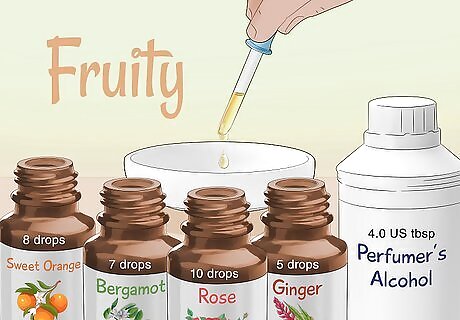
Fruity Blend 8 drops sweet orange 7 drops bergamot 10 drops rose 5 drops ginger 2 fl oz (4.0 US tbsp) of carrier oil or perfumer’s alcohol
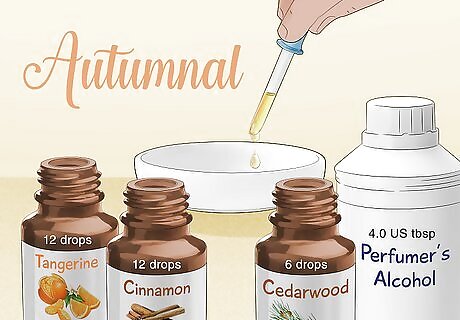
Autumnal Blend 12 drops tangerine 12 drops cinnamon 6 drops cedarwood 2 fl oz (4.0 US tbsp) of carrier oil or perfumer’s alcohol
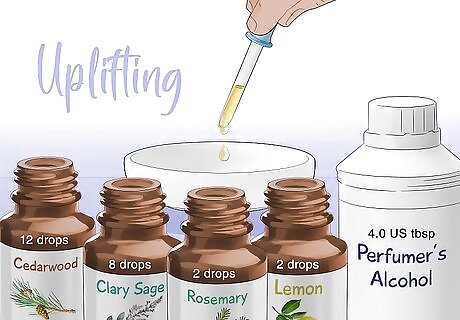
Uplifting Blend 12 drops cedarwood 8 drops clary sage 2 drops rosemary 2 drops lemon 2 fl oz (4.0 US tbsp) of carrier oil or perfumer’s alcohol




















Comments
0 comment